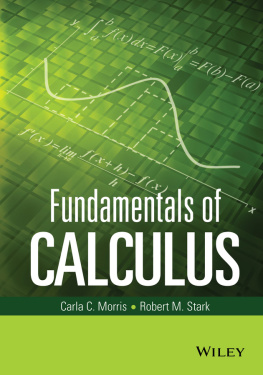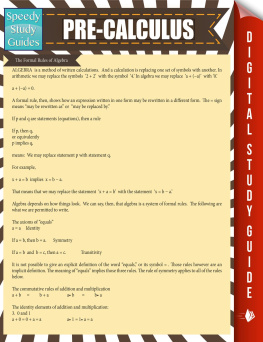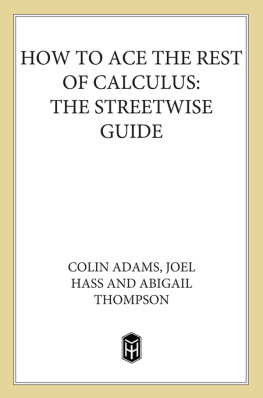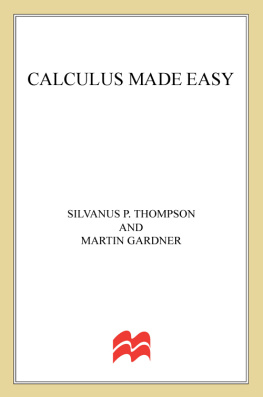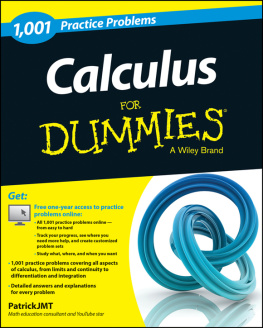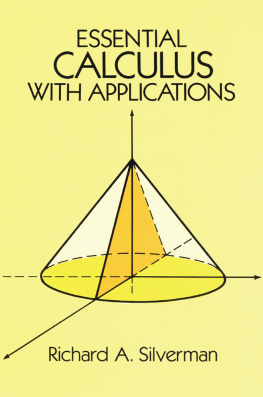
Copyright 2016 by John Wiley & Sons, Inc. All rights reserved
Published by John Wiley & Sons, Inc., Hoboken, New Jersey
Published simultaneously in Canada
No part of this publication may be reproduced, stored in a retrieval system, or transmitted in any form or by any means, electronic, mechanical, photocopying, recording, scanning, or otherwise, except as permitted under Section 107 or 108 of the 1976 United States Copyright Act, without either the prior written permission of the Publisher, or authorization through payment of the appropriate per-copy fee to the Copyright Clearance Center, Inc., 222 Rosewood Drive, Danvers, MA 01923, (978) 750-8400, fax (978) 750-4470, or on the web at www.copyright.com. Requests to the Publisher for permission should be addressed to the Permissions Department, John Wiley & Sons, Inc., 111 River Street, Hoboken, NJ 07030, (201) 748-6011, fax (201) 748-6008, or online at http://www.wiley.com/go/permission.
Limit of Liability/Disclaimer of Warranty: While the publisher and author have used their best efforts in preparing this book, they make no representations or warranties with respect to the accuracy or completeness of the contents of this book and specifically disclaim any implied warranties of merchantability or fitness for a particular purpose. No warranty may be created or extended by sales representatives or written sales materials. The advice and strategies contained herein may not be suitable for your situation. You should consult with a professional where appropriate. Neither the publisher nor author shall be liable for any loss of profit or any other commercial damages, including but not limited to special, incidental, consequential, or other damages.
For general information on our other products and services or for technical support, please contact our Customer Care Department within the United States at (800) 762-2974, outside the United States at (317) 572-3993 or fax (317) 572-4002.
Wiley also publishes its books in a variety of electronic formats. Some content that appears in print may not be available in electronic formats. For more information about Wiley products, visit our web site at www.wiley.com.
Library of Congress Cataloging-in-Publication Data:
Morris, Carla C.
Fundamentals of Calculus / Carla C. Morris, Robert M. Stark.
pages cm
Includes bibliographical references and index.
ISBN 978-1-119-01526-0 (cloth)
1. CalculusTextbooks. I. Stark, Robert M., 1930- II. Title.
QA303.2.M67 2015
515dc23
2014042182
Preface
A fundamental calculus course is a staple for students in Business, Economics, and the Natural, Social, and Environmental Sciences, among others. Most topics within this book parallel conventional texts, and they appear here directly, unimpeded by lengthy examples, explanations, data, irrelevances, and redundancies. Examples are the primary means to illustrate concepts and techniques as students readily respond to them. While there are ample Exercises and Supplementary Exercises, distracting abundance is avoided. Arrow symbols interspersed in the text, UP ( ) and DOWN ( ), are used to signal student tips, insights, and general information much as an instructor might to students in class to help their understanding. UP arrows modestly increase text depth while DOWN arrows expand aid to students.
Students often question the importance and usefulness of calculus, and some find math courses confusing and difficult. To address such issues, one goal of the text is for students to understand that calculus techniques involve basic rules used in combinations to solve complex problems. The challenge to students is to disassemble problems into manageable components. For example, a derivative of [(f(x)g(x))/h(x)]r. The text encourages students to use power, quotient, and product rules for solutions. Another goal is to encourage students to understand calculus as the mathematics of change. To help, text examples guide students in modeling skills.
The elements of finite calculus lacking in most texts is a feature in this book, which serves multiple purposes. First, it offers an easier introduction by focusing on change and enables students to compare corresponding topics with differential calculus. Many may argue that it is the more natural calculus for social and other sciences. Besides, and equally important, finite calculus lends itself to modeling and spreadsheets. In Chapters 2 and 5, finite calculus is applied to marginal economic analysis, finance, growth, and decay.
Each chapter begins with an outline of sections, main topics of discussion, and examples. The outline displays topical chapter coverage and aids in finding items of particular interest. The Historical Notes sketch some of the rich 4000-year history of mathematics and its people.
Some students may skip Chapter 1, Linear Equations and Functions while others find it a useful review.
In Chapter 2, The Derivative finite differences are introduced naturally in forming derivatives and is a topic in its own right. Usually absent from applied calculus texts, finite calculus emphasizes understanding calculus as the mathematics of change (not simply rote techniques) and is an aid to popular spreadsheet modeling.
In Chapter 3, Using the Derivative students' newly acquired knowledge of a derivative appears in everyday contexts including marginal economic analysis. Early on, it shows students an application of calculus.
Chapter 4, Exponential and Logarithmic Functions delineates their principles. This chapter appears earlier than in other texts for two reasons. One, it allows for more complex derivatives to be discussed in Chapter 5 to include exponentials and logarithms. Two, it allows for the discussion on finite differences in Chapter 5 to be a lead in for integration in Chapter 6, Integral Calculus.
Chapter 5, Techniques of Differentiation treats the derivatives of products and quotients, maxima, and minima. Finite differences (or finite calculus) appear again in a brief section of this chapter. The anti-differences introduced in Chapter 5 anticipate the basics of integration in Chapter 6.
Chapters 7 and 8, Integration Techniques and Functions of Several Variables respectively, typify most texts. An exception is our inclusion of partial fractions.
Chapter 9, Series and Summations includes important insight to applications.
Chapter 10, Applications to Probability links calculus and probability.
The table below suggests sample topic choices for a basic calculus course:
| Traditional | Enhanced | Two-Semester |
| Chapter | Course | Course | Course |
| 1 Linear Equations and Functions | Selections | Selections | Selections |
| 2 The Derivative |
| 3 Using the Derivative |
| 4 Exponential and Logarithmic |
| Functions |
| 5 Differentiation Techniques | Selections | Selections |
| 6 Integral Calculus |
| 7 Integration Techniques | Selections | Selections |
| 8 Functions of Several Variables | Selections | Selections |
| 9 Series and Summations | Optional | Selections |
| 10 Applications to Probability | Optional | Selections |
Supplements
A modestly priced Student Solutions Manual contains complete solutions.
Suggestions
Suggestions for improvements are welcome.
Next page
